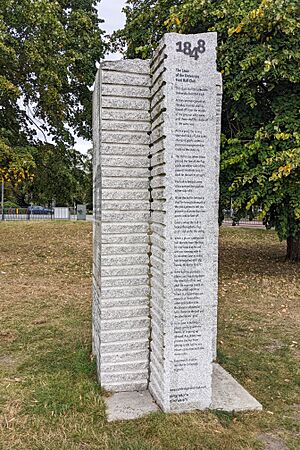Parker's Piece facts for kids
Parker's Piece is a large, open grassy area in the middle of Cambridge, England. It's about 25 acres (100,000 square meters) in size. Many people believe this common land is where the rules for modern association football (soccer) were first created.
Two main paths for walking and cycling cross Parker's Piece diagonally. At the spot where they meet, there's a single lamp-post. People in Cambridge often call this lamp-post Reality Checkpoint. The area is surrounded by streets like Park Terrace, Parkside, Gonville Place, and Regent Terrace.
The first rules for the Cambridge University Football Club were used on Parker's Piece. These rules were later adopted by the Football Association in 1863. An important person from the Football Association, E. C. Morley, said in 1863 that these rules were simple and captured the true spirit of the game. Another FA committee member, C. W. Alcock, also thought the Cambridge Rules were the best choice for the Association.
Today, Parker's Piece is a popular spot for picnics and playing games like football and cricket. It also serves as the sports field for Parkside Community College, which is nearby. Sometimes, daytime events and concerts are held here. One part of the common is still used for league cricket matches.
A huge feast for 15,000 guests took place on Parker's Piece in 1838. This event celebrated the crowning of Queen Victoria. You can also find a blue plaque here that honors Jack Hobbs. He was a famous cricketer, and the plaque is on the wall of a building known as Hobbs Pavilion.
Contents
History of Parker's Piece
Before 1613, Trinity College owned Parker's Piece. In that year, the college traded it with the town of Cambridge. They exchanged it for another piece of land called Garrett Hostel Green. This land is now where the famous Wren Library stands.
Parker's Piece gets its name from Edward Parker. He was a cook at Trinity College. Edward Parker had rented 15 acres of this land from the college since 1587. Another person, Elizabeth Sherwood, held the other 10 acres.
This common was also an important place for cricket. It hosted many first-class matches from 1817 to 1864. In the 1800s, it was one of the main sports grounds for students at the University of Cambridge. They played many important games here, including matches against Oxford.
Parker's Piece and Football
In the 1800s, football was a common game played on Parker's Piece. George Corrie, who was in charge of Jesus College in 1838, wrote about it. He said, "In walking with Willis we passed by Parker's Piece and there saw some forty Gownsmen playing at football. The novelty and liveliness of the scene were amusing!"
The Rules of Football
Parker's Piece holds a special spot in the story of modern football games. This is because different versions of the Cambridge Rules were first tried out here. The 1863 Cambridge rules were even advertised in sports newspapers. They announced a game to be played on November 20, 1863, on Parker's Piece. These rules were very important in creating the first official laws for the Football Association later that year.
Modern Passing Tactics
The Cambridge University AFC moved away from Parker's Piece in 1882. Around this time, the team played a big part in developing the modern passing game, also known as the combination game. Experts say that the Cambridge University team of 1882 was the first "combination" team. This meant each player had a specific area of the field and worked together as a team, focusing on passing the ball. This new style of play changed how football was played forever.
Remembering Football's History
In 2000, a special plaque was put up on Parker's Piece. It was placed there by a football team made up of homeless people. The plaque explains that students here in the 1800s created simple football rules. These rules focused on skill, not force. They also said players couldn't catch the ball or "hack" (kick opponents' shins). These "Cambridge Rules" greatly influenced the Football Association's rules in 1863.
In May 2018, a monument called "Cambridge Rules 1848" was placed on Parker's Piece. This monument has four stone pillars. The 1856 Cambridge Rules are carved into these pillars and translated into several different languages.
Trial Lighting
In January 2013, temporary lights were put along a path on Parker's Piece for a four-week test. This was because people felt unsafe walking through the park after dark. There had been some attacks in the park before this trial.
Parkside Street
Parkside is the street on the north-east side of Parker's Piece. Since 2006, it has been the main stop for long-distance coach services and visitor buses. Local buses also stop here. The city's police and fire stations are on this street. It also provides access to Parkside Community College.
Images for kids
-
Looking towards Our Lady and the English Martyrs Church
-
The Catholic church of Our Lady and the English Martyrs viewed from Parker's Piece.
See also
- Christ's Pieces
- Jesus Green















